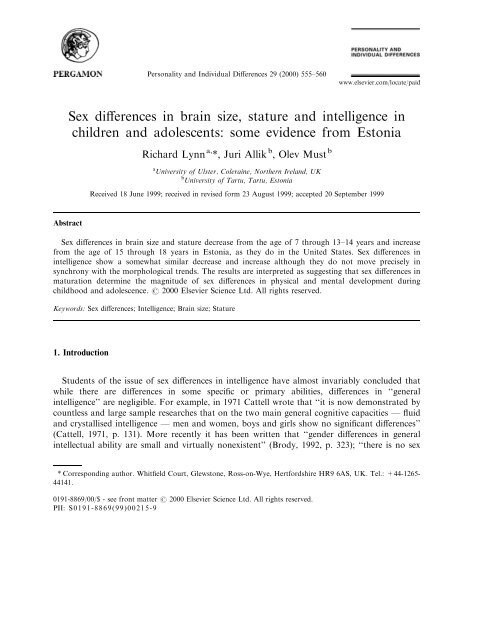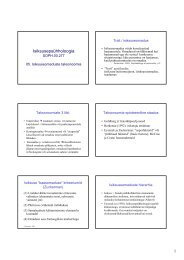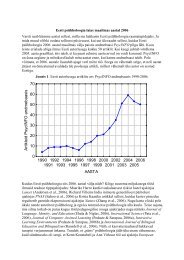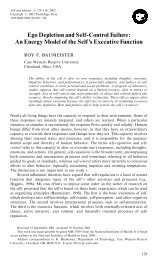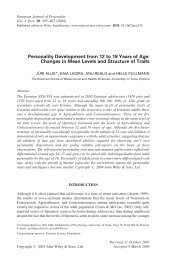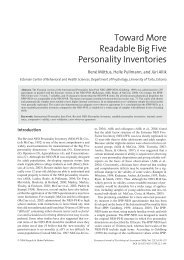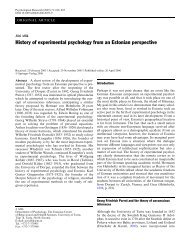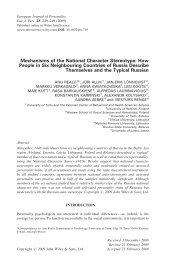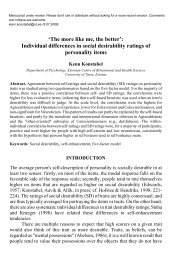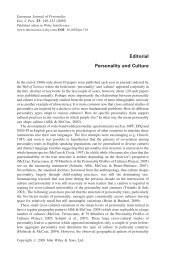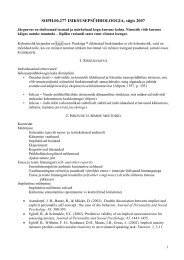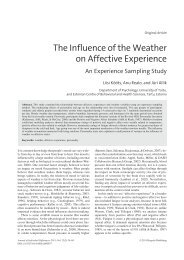Sex differences in brain size, stature and intelligence in children and ...
Sex differences in brain size, stature and intelligence in children and ...
Sex differences in brain size, stature and intelligence in children and ...
You also want an ePaper? Increase the reach of your titles
YUMPU automatically turns print PDFs into web optimized ePapers that Google loves.
Personality <strong>and</strong> Individual Di€erences 29 (2000) 555±560<br />
www.elsevier.com/locate/paid<br />
<strong>Sex</strong> di€erences <strong>in</strong> bra<strong>in</strong> <strong>size</strong>, <strong>stature</strong> <strong>and</strong> <strong>in</strong>telligence <strong>in</strong><br />
<strong>children</strong> <strong>and</strong> adolescents: some evidence from Estonia<br />
Richard Lynn a, *, Juri Allik b , Olev Must b<br />
a University of Ulster, Colera<strong>in</strong>e, Northern Irel<strong>and</strong>, UK<br />
b University of Tartu, Tartu, Estonia<br />
Received 18 June 1999; received <strong>in</strong> revised form 23 August 1999; accepted 20 September 1999<br />
Abstract<br />
<strong>Sex</strong> di€erences <strong>in</strong> bra<strong>in</strong> <strong>size</strong> <strong>and</strong> <strong>stature</strong> decrease from the age of 7 through 13±14 years <strong>and</strong> <strong>in</strong>crease<br />
from the age of 15 through 18 years <strong>in</strong> Estonia, as they do <strong>in</strong> the United States. <strong>Sex</strong> di€erences <strong>in</strong><br />
<strong>in</strong>telligence show a somewhat similar decrease <strong>and</strong> <strong>in</strong>crease although they do not move precisely <strong>in</strong><br />
synchrony with the morphological trends. The results are <strong>in</strong>terpreted as suggest<strong>in</strong>g that sex di€erences <strong>in</strong><br />
maturation determ<strong>in</strong>e the magnitude of sex di€erences <strong>in</strong> physical <strong>and</strong> mental development dur<strong>in</strong>g<br />
childhood <strong>and</strong> adolescence. 7 2000 Elsevier Science Ltd. All rights reserved.<br />
Keywords: <strong>Sex</strong> di€erences; Intelligence; Bra<strong>in</strong> <strong>size</strong>; Stature<br />
1. Introduction<br />
Students of the issue of sex di€erences <strong>in</strong> <strong>in</strong>telligence have almost <strong>in</strong>variably concluded that<br />
while there are di€erences <strong>in</strong> some speci®c or primary abilities, di€erences <strong>in</strong> ``general<br />
<strong>in</strong>telligence'' are negligible. For example, <strong>in</strong> 1971 Cattell wrote that ``it is now demonstrated by<br />
countless <strong>and</strong> large sample researches that on the two ma<strong>in</strong> general cognitive capacities Ð ¯uid<br />
<strong>and</strong> crystallised <strong>in</strong>telligence Ð men <strong>and</strong> women, boys <strong>and</strong> girls show no signi®cant di€erences''<br />
(Cattell, 1971, p. 131). More recently it has been written that ``gender di€erences <strong>in</strong> general<br />
<strong>in</strong>tellectual ability are small <strong>and</strong> virtually nonexistent'' (Brody, 1992, p. 323); ``there is no sex<br />
* Correspond<strong>in</strong>g author. Whit®eld Court, Glewstone, Ross-on-Wye, Hertfordshire HR9 6AS, UK. Tel.: +44-1265-<br />
44141.<br />
0191-8869/00/$ - see front matter 7 2000 Elsevier Science Ltd. All rights reserved.<br />
PII: S0191-8869(99)00215-9
556<br />
R. Lynn et al. / Personality <strong>and</strong> Individual Di€erences 29 (2000) 555±560<br />
di€erence <strong>in</strong> general <strong>in</strong>telligence worth speak<strong>in</strong>g of'' (Mack<strong>in</strong>tosh, 1996); ``gender di€erences<br />
tend to approach zero if researchers employ general or relatively unselected samples''<br />
(Richardson, 1997); ``the sex di€erence <strong>in</strong> psychometric g is either totally nonexistent or is of<br />
uncerta<strong>in</strong> direction <strong>and</strong> of <strong>in</strong>consequential magnitude'' (Jensen, 1998, p. 540).<br />
This unanimous conclusion has been challenged by Lynn (1994, 1996, 1998) who advances<br />
the follow<strong>in</strong>g propositions: (1) the issue of sex di€erences <strong>in</strong> <strong>in</strong>telligence needs to be analysed<br />
developmentally because girls mature faster than boys over the age range 8±15 years; from the<br />
age of 8 years the growth rate of girls beg<strong>in</strong>s to accelerate, <strong>in</strong> relation to that of boys, so that<br />
girls are on average taller <strong>and</strong> heavier than boys between the ages of 8±15; from the age of 16<br />
years onwards, the growth rate of girls slows relative to boys, with the result that boys become<br />
taller <strong>and</strong> heavier than girls; (2) these maturational sex di€erences <strong>in</strong> height <strong>and</strong> weight are also<br />
present <strong>in</strong> head <strong>size</strong>, which is itself an approximate measure of bra<strong>in</strong> <strong>size</strong>; the bra<strong>in</strong> <strong>size</strong> of girls<br />
<strong>in</strong>creases relative to that of boys from the age of 8 years up to the ages of 13±14 years, after<br />
which it beg<strong>in</strong>s to decrease progressively up to the age of 18 years <strong>and</strong> possibly beyond;<br />
however, unlike height <strong>and</strong> weight, the head <strong>size</strong>/bra<strong>in</strong> <strong>size</strong> of girls does not become absolutely<br />
larger than that of boys over the 8±15 year age range, but only becomes relatively larger; (3)<br />
sex di€erences <strong>in</strong> <strong>in</strong>telligence follow the same developmental sequence as those <strong>in</strong> height,<br />
weight <strong>and</strong> bra<strong>in</strong> <strong>size</strong>, i.e. they move <strong>in</strong> favour of girls over the age range 8±15 years, but from<br />
16 years onwards they move <strong>in</strong> favour of boys; (4) thus, sex di€erences <strong>in</strong> <strong>in</strong>telligence are small<br />
over the age range 8±15 years, but they beg<strong>in</strong> to <strong>in</strong>crease progressively <strong>in</strong> favour of males from<br />
the age of 16 years onwards until among adults they become appreciable, rang<strong>in</strong>g between 2±<br />
11 IQ po<strong>in</strong>ts <strong>in</strong> di€erent samples reviewed <strong>in</strong> Lynn (1994, 1996, 1998) <strong>and</strong> Allik, Must <strong>and</strong><br />
Lynn (1999); (5) the developmental trends <strong>in</strong> sex di€erences <strong>in</strong> bra<strong>in</strong> <strong>size</strong> <strong>and</strong> <strong>in</strong>telligence move<br />
<strong>in</strong> parallel because bra<strong>in</strong> <strong>size</strong> is a determ<strong>in</strong>ant of <strong>in</strong>telligence, the evidence for which is reviewed<br />
by Rushton (1995).<br />
In this paper we exam<strong>in</strong>e this theory further <strong>in</strong> a report of data from Estonia for sex<br />
di€erences <strong>in</strong> <strong>in</strong>telligence, head <strong>size</strong> <strong>and</strong> <strong>stature</strong> among <strong>children</strong> <strong>and</strong> adolescents.<br />
2. Method<br />
2.1. Intelligence test data<br />
The <strong>in</strong>telligence data to be presented were collected <strong>in</strong> Estonia by the late Juhan Tork <strong>in</strong><br />
1933±1934 <strong>and</strong> published <strong>in</strong> Estonian <strong>in</strong> 1940 (Tork, 1940). The study has never entered the<br />
world literature on <strong>in</strong>telligence because shortly after it was published the Russians occupied<br />
Estonia, prohibited academic work on <strong>in</strong>telligence <strong>in</strong> conformity with prevail<strong>in</strong>g policy<br />
throughout the Soviet Union <strong>and</strong> removed from circulation most copies of the book. A few<br />
copies survived but because the book was proscribed it was never translated <strong>in</strong>to English or<br />
any other major language <strong>and</strong> consequently has rema<strong>in</strong>ed unknown to the <strong>in</strong>ternational<br />
community.<br />
Tork's study consisted of a collection of data for <strong>in</strong>telligence from a representative sample of<br />
3019 school <strong>children</strong> aged 9±15 years, with approximately equal numbers of boys <strong>and</strong> girls.<br />
The test was an Estonian adaptation of the American National Intelligence Test developed by
Haggerty, Terman, Thorndike, Whipple <strong>and</strong> Yerkes (1919). It is a group test of verbal<br />
reason<strong>in</strong>g <strong>and</strong> verbal comprehension conta<strong>in</strong><strong>in</strong>g problems <strong>in</strong> arithmetic, sentence completion,<br />
logical <strong>in</strong>ference, synonyms±antonyms, <strong>in</strong>formation, vocabulary, analogies <strong>and</strong> comparisons.<br />
The means of the boys <strong>and</strong> girls for each year of age, the d's (the sex di€erences divided by the<br />
pooled st<strong>and</strong>ard deviation) <strong>and</strong> the t values for the sex di€erences are presented <strong>in</strong> Table 1.<br />
The broad pattern of the results is that at age 9 there is no statistically signi®cant sex<br />
di€erence; at age 10 girls obta<strong>in</strong> a signi®cantly higher mean IQ than boys; from age 11 through<br />
15 boys obta<strong>in</strong> higher mean IQs than girls; <strong>and</strong> these di€erences are statistically signi®cant<br />
except at age 12.<br />
2.2. Anthropometric data<br />
R. Lynn et al. / Personality <strong>and</strong> Individual Di€erences 29 (2000) 555±560 557<br />
The anthropometric data were collected on Estonian school <strong>children</strong> <strong>and</strong> adolescents <strong>in</strong> the<br />
early 1950s by the late Juhan Aul (1977), professor of anthropology at the University of Tartu.<br />
The data consist of measures of head width (frontal) <strong>and</strong> head length (saggital) <strong>and</strong> also of<br />
<strong>stature</strong>. We have calculated cranial capacities <strong>in</strong> cubic centimetres from the head width <strong>and</strong><br />
head length data, us<strong>in</strong>g the formula proposed by Lee <strong>and</strong> Pearson (1901) as modi®ed by<br />
Rushton (1995) who subtracts 11 mm from the width <strong>and</strong> length to allow for fat <strong>and</strong> sk<strong>in</strong><br />
around the skull. For males this formula is: cc ˆ 6:752 …L 11 mm† ‡11:421 …B 11 mm† <br />
1434:06; for females: cc ˆ 7:884 …L 11 mm† ‡10:842 …B 11 mm† 1593:96: These data are<br />
presented <strong>in</strong> Table 2. With regard to <strong>stature</strong>, it will be noted that boys are taller than girls<br />
from the ages of 7±10 years; from the age of 12 through 13 girls are taller than boys; from the<br />
age of 15 onwards, boys are aga<strong>in</strong> taller than girls. With regard to head <strong>size</strong>, it will be noted<br />
that boys have larger heads throughout the age range but the di€erence narrows from 123.80<br />
cc at age 7 to 109.09 cc at age 13, <strong>and</strong> then widens to 159.67 cc at age 18.<br />
The most useful way of treat<strong>in</strong>g the data is to consider the <strong>stature</strong> <strong>and</strong> head <strong>size</strong> of females<br />
over the age range as percentages of those of males. These results are shown <strong>in</strong> Table 3<br />
together with, for comparison, the correspond<strong>in</strong>g American data given by Lynn (1994). It will<br />
be noted that the two sets of data show a close similarity. In regard to <strong>stature</strong>, the girls grow<br />
Table 1<br />
Means for boys <strong>and</strong> girls on <strong>in</strong>telligence<br />
Age (years) Boys Girls d t a<br />
N mean S.D. N mean S.D.<br />
9 95 130.9 44.2 68 121.2 44.8 0.22 1.37<br />
10 252 138.5 48.3 186 153.7 45.6 0.32 3.32 <br />
11 235 175.7 59.1 255 161.7 49.0 0.26 2.84 <br />
12 319 200.0 55.3 368 195.1 55.1 0.09 1.16<br />
13 289 228.0 58.6 337 217.8 56.8 0.18 2.20 <br />
14 177 234.3 54.9 211 221.6 54.6 0.23 2.28 <br />
15 108 236.3 45.8 119 218.8 48.9 0.37 2.78 <br />
a Statistical signi®cance at the p ˆ 0:05 <strong>and</strong> p ˆ 0:01:.
558<br />
R. Lynn et al. / Personality <strong>and</strong> Individual Di€erences 29 (2000) 555±560<br />
Table 2<br />
Means for boys <strong>and</strong> girls on head length <strong>and</strong> width (mm), bra<strong>in</strong> volume (cc) <strong>and</strong> <strong>stature</strong> (mm)<br />
Age (years) Number Head length Head width Bra<strong>in</strong> volume Stature<br />
boys girls boys girls boys girls boys girls boys girls<br />
7 623 626 179.35 175.29 149.10 145.18 1279.88 1156.08 121.85 120.80<br />
8 1215 1205 180.18 176.10 149.71 145.65 1290.45 1167.56 126.74 125.74<br />
9 1355 1300 181.09 176.97 150.41 146.30 1306.45 1181.47 131.05 130.64<br />
10 1402 1373 182.09 177.89 151.00 146.79 1320.08 1194.04 136.55 135.70<br />
11 1466 1419 183.02 179.20 151.63 147.50 1333.55 1212.06 141.36 141.37<br />
12 1538 1544 184.05 180.60 152.30 148.48 1348.16 1238.72 146.22 147.46<br />
13 1517 1517 185.19 181.94 152.97 149.42 1363.57 1254.48 151.41 152.72<br />
14 1500 1476 186.60 182.90 153.72 150.08 1381.60 1269.20 157.30 157.30<br />
15 1387 1465 188.20 183.64 154.63 151.03 1402.79 1285.34 163.90 159.90<br />
16 1213 1276 189.61 184.18 155.44 151.56 1421.56 1295.34 168.87 161.17<br />
17 970 1091 191.22 184.64 156.28 151.82 1442.03 1301.79 172.20 162.20<br />
18 666 903 192.80 184.80 157.11 151.77 1462.18 1302.51 174.10 162.53<br />
more rapidly than boys from the age of 8 years; the female advantage peaks at ages 13±14 <strong>in</strong><br />
both data sets <strong>and</strong> then decl<strong>in</strong>es; boys become <strong>in</strong>creas<strong>in</strong>gly taller than girls from the age of 15<br />
onwards. The correlation between the two sets of ®gures is 0.94 ( p < 0.001). In regard to head<br />
<strong>size</strong>, the di€erences between boys <strong>and</strong> girls decl<strong>in</strong>e steadily from the age of 7 to 13/14, after<br />
which they <strong>in</strong>crease aga<strong>in</strong> up to age 18. The correlation between the two data sets is 0.93 ( p <<br />
0.001)<br />
Table 3<br />
Bra<strong>in</strong> <strong>size</strong> <strong>and</strong> <strong>stature</strong> of girls as percentage of boys <strong>in</strong> Estonia <strong>and</strong> the United States<br />
Age (years) Bra<strong>in</strong> <strong>size</strong> Stature<br />
Estonia United States Estonia United States<br />
7 90.33 90.2 99.1 98.5<br />
8 90.48 90.6 99.2 101.1<br />
9 90.42 90.6 99.7 101.0<br />
10 90.45 90.4 99.4 101.7<br />
11 90.89 91.4 100.0 100.3<br />
12 91.51 92.2 100.8 101.3<br />
13 92.00 92.5 100.9 101.3<br />
14 91.86 92.6 100.0 102.0<br />
15 91.63 91.5 97.6 99.3<br />
16 91.12 91.2 95.4 97.1<br />
17 90.27 89.2 94.2 93.6<br />
18 89.08 93.4 92.9
R. Lynn et al. / Personality <strong>and</strong> Individual Di€erences 29 (2000) 555±560 559<br />
3. Discussion<br />
The results conta<strong>in</strong> three pr<strong>in</strong>cipal po<strong>in</strong>ts of <strong>in</strong>terest. First, they provide con®rmation that<br />
girls mature faster than boys over the age range of 7/8 years to around 15 years. This appears<br />
<strong>in</strong> the Estonian data for both <strong>stature</strong> <strong>and</strong> head <strong>size</strong>, for which the sex di€erences decrease over<br />
this age range <strong>in</strong> a manner closely similar to that <strong>in</strong> the United States.<br />
Secondly, the sex di€erences <strong>in</strong> <strong>in</strong>telligence also show some narrow<strong>in</strong>g <strong>and</strong> subsequent<br />
broaden<strong>in</strong>g over the same age range. A small <strong>and</strong> nonsigni®cant di€erence at age 9 is followed<br />
by a signi®cant di€erence <strong>in</strong> favor of girls at age 10, which is <strong>in</strong> turn followed by di€erences <strong>in</strong><br />
favor of boys from the age of 11 through 15. The results con®rm <strong>in</strong> general terms the thesis<br />
that the analysis of sex di€erences <strong>in</strong> <strong>in</strong>telligence requires close attention to age di€erences.<br />
Thus <strong>in</strong> these data the statement that ``there are no sex di€erences <strong>in</strong> <strong>in</strong>telligence'' is true for<br />
age 9 but untrue for ages 10 <strong>and</strong> 11.<br />
Thirdly, although the sex di€erences <strong>in</strong> bra<strong>in</strong> <strong>size</strong> <strong>and</strong> <strong>stature</strong> <strong>and</strong> for <strong>in</strong>telligence show the<br />
same general trend of a narrow<strong>in</strong>g <strong>and</strong> subsequent broaden<strong>in</strong>g over the age range 9±15 years,<br />
they do not move <strong>in</strong> perfect synchrony. The girls' advantage <strong>in</strong> <strong>in</strong>telligence peaks at the age of<br />
10, while their advantage for <strong>stature</strong> peaks at the age of 13 <strong>and</strong> their disadvantage <strong>in</strong> respect of<br />
bra<strong>in</strong> <strong>size</strong> is smallest at the age of 13. Possibly the explanation for this lack of synchrony is<br />
that the ``growth spurt'' of girls which beg<strong>in</strong>s to occur at the age of 7/8 years has di€erent<br />
trajectories for di€erent morphological <strong>and</strong> physiological characteristics. For example, the<br />
myel<strong>in</strong>isation of the bra<strong>in</strong> neurones <strong>in</strong>creases dur<strong>in</strong>g childhood <strong>and</strong> adolescence <strong>and</strong> is<br />
positively related to <strong>in</strong>telligence (Miller, 1994). It is possible that this or some similar process<br />
may occur more rapidly <strong>in</strong> girls <strong>and</strong> match more precisely the accelerated development of girls'<br />
<strong>in</strong>telligence around the age of 10 years.<br />
References<br />
Allik, J., Must, O., & Lynn, R. (1999). <strong>Sex</strong> di€erences <strong>in</strong> general <strong>in</strong>telligence among high school graduates: some<br />
results from Estonia. Personality <strong>and</strong> Individual Di€erences, 26, 1137±1141.<br />
Aul, J. (1977). Uber den <strong>Sex</strong>ualdimorphismus der anthropometrischen Merkmale von Sculk<strong>in</strong>dern, Jugendlichen<br />
und Erwachsehen. Homo, 28, 201±216.<br />
Brody, N. (1992). Intelligence. New York: Academic.<br />
Cattell, R. B. (1971). Abilities: their structure, growth <strong>and</strong> action. Boston: Houghton Mi‚<strong>in</strong>.<br />
Haggerty, M. E., Terman, L. M., Thorndike, E. L., Whipple, G. M., & Yerkes, R. M. (1919). National <strong>in</strong>telligence<br />
test. London: Harrap.<br />
Jensen, A. R. (1998). The g factor. Westport, CT: Praeger.<br />
Lee, A., & Pearson, K. (1901). Data for the problem of evolution <strong>in</strong> man. VI. A ®rst study of the correlation of the<br />
human skull. Philosophical Transactions of the Royal Society of London, 196A, 225±264.<br />
Lynn, R. (1994). <strong>Sex</strong> di€erences <strong>in</strong> <strong>in</strong>telligence <strong>and</strong> bra<strong>in</strong> <strong>size</strong>: a paradox resolved. Personality <strong>and</strong> Individual<br />
Di€erences, 17, 257±271.<br />
Lynn, R. (1996). Di€erences between males <strong>and</strong> females <strong>in</strong> mean IQ <strong>and</strong> university performance <strong>in</strong> Irel<strong>and</strong>.<br />
Personality <strong>and</strong> Individual Di€erences, 20, 649±652.<br />
Lynn, R. (1998). <strong>Sex</strong> di€erences <strong>in</strong> general <strong>in</strong>telligence: a rejo<strong>in</strong>der to Mack<strong>in</strong>tosh. Journal of Biosocial Science, 30,<br />
529±532.<br />
Mack<strong>in</strong>tosh, N. J. (1996). <strong>Sex</strong> di€erences <strong>and</strong> IQ. Journal of Biosocial Science, 28, 559±572.
560<br />
R. Lynn et al. / Personality <strong>and</strong> Individual Di€erences 29 (2000) 555±560<br />
Miller, E. M. (1994). Intelligence <strong>and</strong> bra<strong>in</strong> myel<strong>in</strong>isation: a hypothesis. Personality <strong>and</strong> Individual Di€erences, 17,<br />
803±832.<br />
Richardson, J. T. (1997). Conclusions from the study of di€erences <strong>in</strong> cognition. In P. J. Caplan, M. Crawford, J. S.<br />
Hyde, & J. T. Richardson, Gender di€erences <strong>in</strong> human cognition. Oxford: Oxford University Press.<br />
Rushton, J. P. (1995). Race, evolution <strong>and</strong> behavior. New Brunswick, NJ: Transaction.<br />
Tork, J. (1940). Eesti laste <strong>in</strong>telligents. Tartu: Koolivara.


